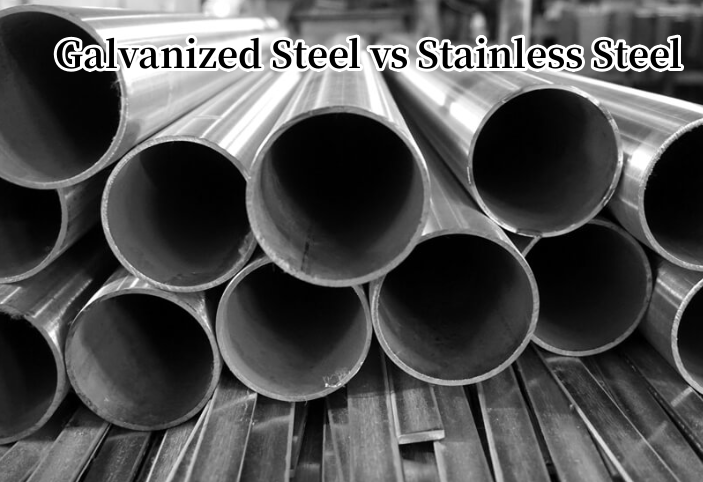Stainless steel and galvanized steel pipes are two common types of pipes in the steel industry. When we choose pipe materials, we can’t help but ask ourselves: which is better, stainless steel pipe or galvanized steel pipe?

What is Galvanized Steel?
Widely used in various fields such as architecture, handicrafts, woven wire mesh, highway guardrails, product packaging, and daily civilian use. Electrogalvanizing has been widely used in mechanical manufacturing, galvanized wire mesh production, electronics, precision instruments, chemical engineering, transportation, aerospace and other fields.
Galvanized wire can be divided into hot dip galvanized wire and cold dip galvanized wire (galvanized wire). The difference is that the hot-dip galvanizing line is immersed in molten zinc by heating, resulting in fast production speed and uneven coating thickness. The minimum thickness allowed by the market is 45 microns, and the maximum thickness can reach over 300 microns. The color is darker, consumes more zinc metal, and forms a penetrating layer with the base metal. It has good corrosion resistance and can be maintained for decades in outdoor environments through hot-dip galvanizing.
What is Stainless Steel?
Stainless steel is mainly used for building purposes such as curtain walls, side walls, roofs, and elevator decorative panels in the field of architecture. Chromium containing stainless steel also combines mechanical strength and high ductility for processing and manufacturing components. It is also used for manufacturing primary and secondary tableware, kitchenware, water heaters, water dispensers, etc.
What is the Difference Between Galvanized and Stainless Steel?
1. Different concepts; Galvanizing refers to coating a layer of metal zinc on the surface of a steel plate to prevent corrosion and extend its service life. This type of galvanized steel sheet is called galvanized steel sheet. Stainless steel refers to steel that can resist weak corrosive media such as air, steam, water, and chemical corrosive media such as acid, alkali, and salt. It is also known as stainless steel and acid resistant steel.
2. Different processing techniques; Galvanizing is the process of applying metal plating to the surface, while stainless steel is the process of adding other metals to prevent rusting.
3. Different application fields; Galvanized steel plates and strip products are mainly used in industries such as construction, light industry, automotive, agriculture, animal husbandry, fisheries, and commerce. For example, used for building roof panels, roof grilles, etc; Kitchen utensils, etc; Storage and transportation of materials, packaging tools, etc. Stainless steel is mainly used in the construction field and is one of the strongest metal materials used in construction. It is also used in areas with high hygiene requirements such as food processing, catering, brewing, and chemical engineering.
Should You Choose Galvanized Steel or Stainless Steel?
1. Material characteristics
Stainless steel pipe is a type of pipe material with corrosion resistance, mainly composed of iron, chromium, and nickel. It can resist the erosion of oxidizing, acidic, and alkaline media, therefore it has good corrosion resistance. Stainless steel pipes have a smooth surface and are easy to clean, making them widely used in industries that require high hygiene standards, such as food processing and medical devices.
Galvanized steel pipes are pipes that are coated with a layer of zinc metal on their surface. Galvanized coating can effectively prevent steel pipes from being oxidized and corroded, improving their durability and corrosion resistance. Galvanized steel pipes typically have a long service life and relatively low prices, making them widely used in some common engineering projects.
2. Corrosion resistance
Stainless steel pipes have excellent corrosion resistance due to their inclusion of alloy elements such as chromium and nickel. Stainless steel pipes can resist the erosion of most chemical media and are less prone to rusting, making them suitable for long-term use in humid, acidic, and alkaline environments. Stainless steel pipes are widely used in marine engineering, chemical equipment, aerospace and other fields, especially suitable for occasions requiring high corrosion resistance.
The anti-corrosion performance of galvanized steel pipes is relatively good, but slightly inferior to stainless steel pipes. Although the galvanized layer can to some extent block the corrosion of steel pipes, over time, the galvanized layer may be damaged, leading to the steel pipes starting to rust. Therefore, in some environments with high requirements for corrosion resistance, stainless steel pipes are more ideal.
3. Operating temperature
When selecting pipes, temperature is also a factor to consider.
Stainless steel pipes can maintain good performance at higher temperatures and can generally be used in the temperature range of -196 ℃ to 800 ℃. This makes stainless steel pipes highly stable in high-temperature environments and suitable for the manufacturing of high-temperature furnaces, boilers, and other equipment.
The performance of galvanized steel pipes is relatively poor at high temperatures. Due to the characteristics of the galvanized layer, galvanized steel pipes are prone to oxidation reactions in high-temperature environments above 400 ℃, leading to damage to the galvanized layer and affecting the service life of the steel pipes. Therefore, under high temperature conditions, stainless steel pipes are a more reliable choice.
4. Application Scenario
Based on the above characteristics, there are certain differences in application scenarios between stainless steel pipes and galvanized steel pipes.
Stainless steel pipes are widely used in industries such as chemical, pharmaceutical, and food due to their excellent corrosion resistance and high-temperature stability. For example, in the food processing process, stainless steel pipes can ensure the hygiene and safety of products; In chemical equipment, stainless steel pipes can resist the erosion of corrosive media.
Galvanized steel pipes are mainly used in some ordinary engineering projects, such as water supply, natural gas and other transportation systems. Galvanized steel pipes can provide certain anti-corrosion performance and are suitable for situations with relatively low requirements for corrosion resistance. In addition, due to the relatively low price of galvanized steel pipes, they are often used in some economically important engineering projects.

